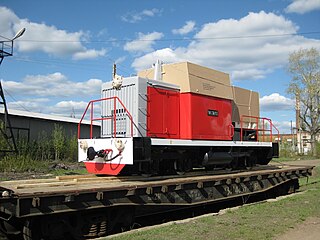| TU8G | |||||||||||||||||||||||||||||||
|---|---|---|---|---|---|---|---|---|---|---|---|---|---|---|---|---|---|---|---|---|---|---|---|---|---|---|---|---|---|---|---|
Kambarka engineering plant, Russia | |||||||||||||||||||||||||||||||
| |||||||||||||||||||||||||||||||
| |||||||||||||||||||||||||||||||
| |||||||||||||||||||||||||||||||
| |||||||||||||||||||||||||||||||
The TU8G (ТУ8Г) is a Soviet, later Russian diesel locomotive for track gauge 750 mm (2 ft 5 1⁄2 in).
| TU8G | |||||||||||||||||||||||||||||||
|---|---|---|---|---|---|---|---|---|---|---|---|---|---|---|---|---|---|---|---|---|---|---|---|---|---|---|---|---|---|---|---|
Kambarka engineering plant, Russia | |||||||||||||||||||||||||||||||
| |||||||||||||||||||||||||||||||
| |||||||||||||||||||||||||||||||
| |||||||||||||||||||||||||||||||
| |||||||||||||||||||||||||||||||
The TU8G (ТУ8Г) is a Soviet, later Russian diesel locomotive for track gauge 750 mm (2 ft 5 1⁄2 in).

The diesel locomotive TU8G (ТУ8Г) is designed for loading and unloading and also general purpose locomotive for Narrow gauge railways. The TU8G was developed in 1987 - 1988 at the Kambarka Engineering Works to replace the aging locomotive classes TU6D (ТУ6Д). The TU8G was designed to be used on any gauge from 750 mm (2 ft 5 1⁄2 in) – 1,067 mm (3 ft 6 in). The cab is equipped with heat-system, refrigerator, radio-set and air conditioning. [1] TU8G № 0022 - 0027 made on the 1,067 mm (3 ft 6 in) for the Sakhalin Railway. [2]

A narrow-gauge railway is a railway with a track gauge narrower than standard 1,435 mm. Most narrow-gauge railways are between 600 mm and 1,067 mm.

A Fairlie is a type of articulated steam locomotive that has the driving wheels on bogies. The locomotive may be double-ended or single ended. Fairlies are most associated with the Ffestiniog Railway in Wales.

With railways, a break of gauge occurs where a line of one gauge meets a line of a different gauge. Trains and rolling stock cannot run through without some form of conversion between gauges, and freight and passengers must otherwise be transshipped. A break of gauge adds delays, cost, and inconvenience.

The Indian Railways primarily operates electric and diesel locomotives. Steam locomotives are operated on a few World Heritage sites and also run occasionally as heritage trains. A locomotive is also known as a loco or engine. The country's first steam locomotive ran on the Red Hill Railway from Red Hills to the Chintadripet bridge in Madras in 1837.
B-B and Bo-Bo are the Association of American Railroads (AAR) and British classifications of wheel arrangement for railway locomotives with four axles in two individual bogies. They are equivalent to the B′B′ and Bo′Bo′ classifications in the UIC system. The arrangement of two, two-axled, bogies is a common wheel arrangement for modern electric and diesel locomotives.

Railways with a railway track gauge of 5 ft were first constructed in the United Kingdom and the United States. This gauge is also commonly called Russian gauge because this gauge was later chosen as the common track gauge for the Russian Empire and its neighbouring countries. The gauge was redefined by Soviet Railways to be 1,520 mm.

TU2 (ТУ2) is a Soviet narrow gauge diesel locomotive for the track gauge of 750 mm

Bogie exchange is a system for operating railway wagons on two or more gauges to overcome difference in the track gauge. To perform a bogie exchange, a car is converted from one gauge to another by removing the bogies or trucks, and installing a new bogie with differently spaced wheels. It is generally limited to wagons and carriages, though diesel locomotives can be exchanged if enough time is available.

Gauge conversion is the change of one railway track gauge to another. This may be required if loads are too heavy for the existing track gauge or if rail cars are of a broader gauge than the existing track gauge. Gauge conversion may become less important as time passes due to the development of variable gauge systems, also called Automatic Track Gauge Changeover Systems.

Railways with track gauge of 5 ft 3 in are broad gauge railways, currently in use in Australia, Brazil and Ireland.

The South African Railways Class 91-000 of 1973 was a narrow-gauge diesel–electric locomotive.

TU7 (ТУ7) - Soviet, later Russian diesel locomotive for gauge 750 mm – 1,067 mm.

The GE PowerHaul is a class of mainline diesel-electric locomotives designed by General Electric. Thirty locomotives were ordered by Freightliner UK in 2007; the first locomotive was completed in July 2009 at GE's Erie, Pennsylvania plant.

TU8 (ТУ8) – Soviet, later Russian diesel locomotive for gauge 750 mm.

TU8P (ТУ8П) is a Soviet, later Russian diesel locomotive, railcar or draisine for gauge 750 mm.

TU6SPA (ТУ6СПА) is a Soviet, later Russian diesel locomotive and mobile power station for 750 mm track gauge.

TU4 (ТУ4) is a Soviet narrow gauge diesel locomotive for the track gauge of 750 mm.

TU6 (ТУ6) is a Soviet narrow gauge diesel locomotive for the track gauge of 750 mm.

The locomotives TU10 of the Russian Railways (RŽD) are narrow gauge diesel locomotives for children's railways.
| Wikimedia Commons has media related to Type Tu8G diesel locomotives . |
| This diesel locomotive-related article is a stub. You can help Wikipedia by expanding it. |